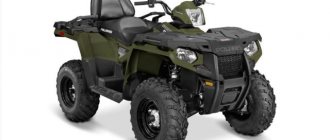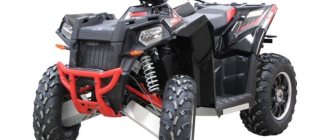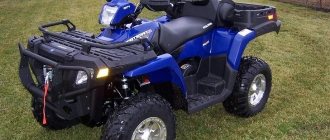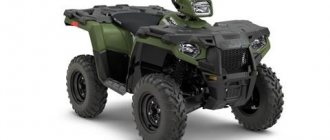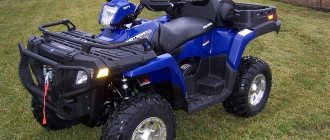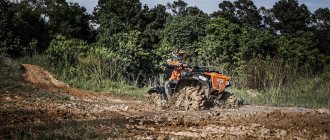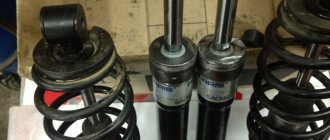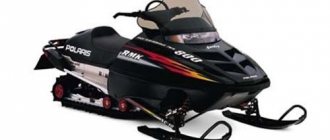The Polaris SPORTSMAN 850 ATV is a two-seat utility model that uses the XP platform as its base. The ATV has a two-cylinder power plant with a total displacement of 850 cubic meters. With this indicator, the motor develops a rated output power of 75 horsepower or 55 kilowatts. This model also comes with a 19.9 liter fuel tank. It is worth noting that there is a version with a 17-liter fuel tank. Polaris 850 has an electric power steering mechanism, which, in addition to providing its main task, also has a positive effect on mitigating shock loads on the front wheels, which together provides increased comfort when driving on rough terrain and off-road.
One of the key features of this ATV is the CRS passenger seat shock absorption system. It additionally ensures riding comfort for both the passenger and the driver. In essence, this system is a fifth shock absorber installed under the passenger seat.
Unlike many other ATVs, the Polaris SPORTSMAN 850 model was equipped with a double-wishbone front suspension, traditional for this type of motorcycle. The rear independent suspension received an additional stabilizer. All this made it possible to significantly increase not only the suspension travel, but also the ground clearance, which, by the way, is now 305 millimeters. Thanks to this, the cross-country ability of the equipment has also increased. In addition, wheels with a 14-inch landing diameter were used here for the first time. The use of such wheels made it possible to improve the car's handling and shock absorption. It should be noted that in many ATVs, in order to soften unevenness, the driver was required to stand on special footrests, while in this model there is practically no such need, except in rather difficult areas.
Polaris 850 uses an all-wheel drive transmission with three operating modes. In the first mode, only the rear-wheel drive of the ATV (2x4) works. In the second mode, all wheels (4x4) are connected, and in this mode the front center differential is automatically connected via an electromagnetic clutch. The third mode is the same all-wheel drive, only here a special system is already connected, which significantly helps when descending, namely, it slows down the ATV due to the transmission.
001_MOTO_0710_018
Polaris Sportsman 850 Touring EPS: tourist and entertainment ATV, 2010, P2, 850 cm³, 70 hp, 363 kg, estimated price - 584,000 rubles.
Polaris Sportsman 850 Touring EPS: tourist and entertainment ATV, 2010, P2, 850 cm³, 70 hp, 363 kg, estimated price - 584,000 rubles.
On the way to the test, I assumed that I would have to torment another large utility vehicle with skids and jumps. But I was wrong. But not in intentions, but in expectations. The fact is that the Sportsman turned out to be not just big, but VERY BIG (for comparison: one and a half times larger than the Honda TRX680FA Rincon). I won’t say that this made me happy or sad, rather it surprised me. And not only the size, but also the layout of the car is very interesting: the in-line engine is located longitudinally, and the variator pulleys are generally located on top of each other! But in fact, this arrangement is very logical: there is no additional gearbox between the variator and the transfer case - there is no power loss in it.
Review from a veteran about the Polaris 850 SKS 146 snowmobile
The SKS 146 with the new 850 Patriot engine is no toy sled. The 850 engine is capable of spinning a short track with small hooks to enormous speeds. It climbs slopes quite well in the right conditions. However, in especially deep and loose snow it sinks or slips; for example, we recently had to pull it out of the slope. True, the snow there was soft and chest-deep, so the SKS was clearly out of its comfort zone on such a slope. The 850 SKS is a compromise between the speed performance of a short track and the holding power of a long track, and yes, it has its limits in super-deep-and-soft snow, but it's still a great sled.
He loves flying. Thanks to its monster 850 engine, the SKS 146 jumps out of a snowdrift like a cork and flies. However, it handles well in all situations with its wide platforms and shallow steering column.
Thanks to the Polaris 850 SKS 146, I've come to realize that in areas where a long-track sled is moving, the 146 can almost glide at high speed. This is a great snowmobile, just understand that it is not a Pro-RMK, but in its role - that is, as a crossover with the ability to ride on loose snow - it is ideal. Moreover, its flat steering column could have worsened handling - but it did not. It handles and rides incredible, helped greatly by the Walker Evans shocks.
009_MOTO_0710_018
The luxury nature of the car is clearly hinted at by the passenger seat with a separate shock absorber, alloy wheels, multi-function instrumentation and electric power steering (to admit, before meeting this Sportsman, I always wrinkled my nose about the ESD, since I had never seen a single similar device with normal feedback). Utility is indicated by the presence of a “lowering” and engine braking mode, a powerful towbar and three headlights (two stationary and one on the steering wheel). Well, as for sportiness - a powerful engine, switchable front-wheel drive and not very toothy tires. In motion, this colossus was somewhat reminiscent of a luxury SUV: the pilot, and especially the passenger, is separated from the quality of the coating by an unbreakable wall of comfort and steadfastness. It’s like in a cartoon: whether you want ice cream or cake, Sportsman Touring allows everything within reasonable limits, but at the same time does not blur their lines.
Polaris Sportsman 850 and Can-Am Outlander 850: two powerful ATVs in facts and figures
I feel like an old man sitting in a rocking chair, wrapped in a blanket, wearing a strict log and telling the neighbor boy about the good old days, when 500 cubic meters for a quad was considered a lot of cubic capacity. “In my time, 700 cubic meters was wow!!!” But with the advent of liter ATVs, 500s have become the “junior level”, and those that were the top segment are now considered “budget quads”. Confusing, right? Polaris and Can-Am each offer an 850cc model, positioning them as affordable cubic capacity machines. Both of them are perfect for those who are not looking for a way to quickly spend as much money as possible on a top-end device. Let's compare the two 2022 models.
002_MOTO_0710_018
Handling is good for a car of this size.
Her enormous weight prevents her from becoming excellent. The bonus from heaviness is the smoothness of the ride. Handling is good for a car of this size. Her enormous weight prevents her from becoming excellent. The bonus from heaviness is the smoothness of the ride.
What struck me most was the operation of the electric power steering: nowhere, I repeat, nowhere have I seen such an adequate device - the steering wheel in any rut or mud can really be turned with one finger, and at speed the feedback from the wheels is simply excellent. In fact, it’s stupid to measure such cars with a sporting yardstick, try to jump on them and put them into a deep skid in turns. It’s not that Sportsman can’t do this, he certainly can, but he asks the driver the question: “why?” It is much more pleasant to keep the engine at half-open throttle, feeling an inexhaustible supply of thrust under the right thumb, to let the suspensions do their job, including the passenger seat suspension, which the manufacturer is so proud of and which saves the rider from constant blows to the kidneys. But a smooth ride is ensured not only by a well-functioning suspension, large wheels and adequate brakes. Let us remember physics: the greater the mass, the greater the inertia of rest. The big heavy car doesn’t move with indifferent steadfastness, but just rushes. Honestly, I would call the dynamics for this quad excessive, and the engine thrust, rather, a luxury item: it doesn’t seem to be particularly needed, but the fact that it is there is damn nice.
Reviews
- Many people praise this ATV, including my good friends. A year ago, based on all this, I decided to purchase this model. Based on first impressions, the technology is really quite good and does not require additional modifications. After some time I started having the first problems. The drive mode switch stopped working, followed by some knocking noises in the engine and so on. At that time, the equipment was under warranty, so these problems were corrected in a special service center. After that, everything seemed to disappear and still works to this day. Otherwise, the ATV is impressive; it has good dynamics, handling and cross-country ability.
- I bought a Polaris 850 from my friend, who took very good care of the technical condition of the car. The ATV is quite good on almost any terrain. I tried driving in snow and sticky mud, it goes everywhere. With a passenger, there is practically no difference in dynamics, except that it is a little more difficult for him on an ascent. As for me, this model is quite excellent for cruising.
003_MOTO_0710_018
Along with luxury, the Sportsman has both a sporty and utilitarian element: with rear-wheel drive you can indulge in deep drifts, with full-wheel drive you can push through quite serious mud or loose sand.
Along with luxury, the Sportsman has both a sporty and utilitarian element: with rear-wheel drive you can indulge in deep drifts, with full-wheel drive you can push through quite serious mud or loose sand.
004_MOTO_0710_018
Here it is, the wall of comfort: when forcing puddles, barely a couple of drops fall on the driver and passenger.
Here it is, the wall of comfort: when forcing puddles, barely a couple of drops fall on the driver and passenger.
But the most interesting thing began when I let my passenger behind the wheel, and I fell apart in the back: it’s extremely rare to hear so much enthusiasm from a woman’s mouth about a heavy ATV. The fragile female body, which had previously driven quads twice in its life, could not be pulled away from the steering wheel until the gas in the tank ran out. They didn’t give me a steering wheel anymore that day, but offered to sit in the back and enjoy myself. That's what I did. You sit in the back as if on a throne, the seat suspension is well tuned to the weight of the average person, but as speeds increase it becomes a little scary because the amplitude of shaking in the passenger seat is considerably greater than in the driver’s seat. But even here there is a lever to influence the situation: the exhaust is quite quiet, so any interesting words addressed to the driver pass well through the two helmets to the remnants of the mind, not seduced by the driving buzz.
Review of the Chieftec Polaris PPS-850FC 850 W power supply
Today we will look at the Chieftec Polaris 850W power supply with a “gold” certificate and fully modular cable connection. This line contains devices from 550 to 1250 W, and our guest occupies almost a middle position between them, being the “starter” model of powerful solutions.
We have already met a representative of less powerful devices earlier using the example of the 750-watt Polaris, and we will try to find out how different they are in design within the framework of this material.
Chieftec Polaris 850W
| Model | Chieftec Polaris 850W (PPS-850FC) |
| Product page | PPS-850FC |
| Power, W | 850 |
| Energy Efficiency Certificate | 80 Plus Gold |
| Form factor | ATX |
| Cable connection diagram | Modular |
| Channel power +12V, W (A) | 850 (70,8) |
| Channel power +5V, W (A) | 110 (22) |
| Channel power +3.3V, W (A) | 72,6 (22) |
| Combined power +3.5V and +5V, W | 120 |
| Channel power –12, W (A) | 3,6 (0,3) |
| Channel power +5Vsb, W (A) | 15 (3) |
| Active PFC | + |
| Mains voltage range, V | 100-240V |
| Mains voltage frequency, Hz | 47–63 |
| Fan size, mm | 135x135x25 |
| Bearing type | Hydrodynamic |
| Number of cables/connectors for CPU | 2/2x EPS12V (4+4) |
| Number of cables/connectors for PCI-E | 2/4x (6+2) |
| Number of cables/connectors for SATA | 3/12 |
| Number of cables/connectors for IDE | 1/4 |
| Protection | OPP, OVP, UVP, SCP, OCP, OTP, SIP |
| Dimensions (WxHxD), mm | 150x86x150 |
| Warranty, months | 24 |
| Price | 3544 UAH |
The unit is packaged in a black box, on the side faces there is a photo of the appearance and all the necessary information about the characteristics of the device, the box is the same for the 850 and 1050 W models.
The delivery set includes: power cable, a set of modular cables packed in a case, a bag with mounting screws and instructions.
The power supply has completely detachable cables, their number and length are as follows:
- one for powering the motherboard (65 cm);
- two with one 8-pin (4+4) connector for powering the processor (65 cm);
- two with two 8-pin (6+2) connectors for powering a PCI-E video card (60+10 cm);
- three with four power connectors for SATA devices (55+10+10+10 cm);
- one with four power connectors for IDE devices (55+10+10+10 cm).
All cables have black insulation and are made in the form of cables, the wires are quite soft and long, the unit is perfect for both compact and large cases with a bottom-mounted unit.
The design of the case is simple: a strict black rectangle, powder-coated, the cooling fan is covered with a black protective grille with a golden manufacturer’s logo in the central part. On the side edges there are black stickers with white inscriptions, which look harmonious and do not greatly detract from the appearance.
The block is made according to a topology that has already become the standard for “golden” blocks: APFC with a wide range of input supply voltage, a resonant LLC converter on the +12 V line with a synchronous rectifier, and DC/DC converters on the +3.3 V and + lines 5 V, stabilization of all voltages, naturally, separately.
At the input of the unit there is a full-fledged impulse noise filter, some of its capacitors are soldered to the network connector, and an additional ferrite core is installed on the cable to the board. The charging current when connected to the network is limited by a thermistor, next to which a relay is installed, which closes it after the unit starts to reduce losses. The input rectifier consists of one diode assembly (the markings, unfortunately, are not visible). The APFC is built on an ICE3PCS01G controller installed on a separate board, on which there is also a WT7527RA supervisor from Weltrend, which is responsible for monitoring output voltages and currents. The power part of the corrector is provided by a pair of IPW60R120P7 transistors (26 A, 650 V, 0.12 Ohm), connected in parallel, and a C3D08060 diode (10 A, 600 V) based on silicon carbide. After the corrector, two electrolytic high-voltage filter capacitors with a capacity of 470 μF and 390 μF with an operating voltage of 400 V at 105 °C of the MXH series manufactured by the Japanese company Rubycon are installed. The total capacitance is 860 µF.
The power converter along the +12 V line is made according to the circuit of a half-bridge resonant LLC converter. A pair of IPA60R180P7 power transistors (18 A, 650 V, 0.18 Ohm) are installed on the radiator along with APFC elements, and they are controlled by a CM6901X combined controller located on a separate board. The synchronous rectifier contains four TPHR8504PL transistors (150A, 40 V, 0.7 mOhm), while there is empty space on the board for four more transistors for a more powerful version. The transistors are cooled by two nickel-plated copper plates soldered into the board. The output voltage is filtered by three 3300 µF electrolytic Low ESR capacitors with an operating voltage of 16 V and a temperature of 105 ° C, manufactured by Teapo SC series, and three 820 µF 16 V polymer capacitors, also from Teapo FG series. The +5VSB standby power supply converter is based on a SI8016HSP8 PWM controller and an ITA04N65R power transistor (4 A, 650 V, 2.8 Ohm). Low ESR capacitors are installed at the output: three with a capacity of 1000 μF and one with a capacity of 2200 μF with a voltage of 16 V, all manufactured by Teapo SC series. We saved a little on the output electrolytic capacitors, but this does not affect the operation and ripple level in any way, because a specialized Low ESR series is used, which works exactly the same as its Japanese counterparts. On the other hand, buyers would be calmer if Japanese capacitors were also at the output.
The +3.3 V and +5 V lines are powered by a step-down DC/DC converter, assembled on a separate board on which a pair of chokes and two pairs of polymer capacitors of 330 µF 16 V and 560 µF 6.3 V are installed. The converter is a synchronous PWM controller APW7159C, using SiRA12BDP transistors (30 V, 60 A, 4.3 mOhm).
On the board with connectors for connecting modular cables, polymer capacitors are installed for additional filtering: three with a capacity of 330 μF 16 V and ten pieces with a capacity of 560 μF 6.3 V.
The components are cooled by a 135 mm fan RL4Z S1352512HH (12 V, 0.45 A) manufactured by Globe Fan with a hydrodynamic bearing and a two-pin connection. The fan is controlled automatically by an STC15W408AS controller installed on a separate board. The control is semi-passive: when the unit starts, the fan does not work and turns on at a power of more than 30% at 650 rpm; with a further increase in power or temperature of the synchronous rectifier transistors along the +12 V line, the fan speed smoothly increases to a maximum of 1800 rpm. Moreover, unlike most units without an STC15W408AS controller, in which, when the load decreases, the speed does not drop much until the rectifier temperature drops, in the same unit the speed drops almost immediately when the load power decreases.
The installation and soldering are of high quality, all components are installed smoothly, large elements are fixed with sealant, the board is cleaned of flux.
Testing methodology
The power supply test was carried out using a linear electronic load with the following parameters: current adjustment ranges on the +3.3 V line - 0-16 A, on the +5 V line - 0-22 A, on the +12 V line - 0-60 A The error of measuring current and voltage by the stand is 5%, all contacts for connecting cables of the tested power supply with the same voltage are connected in parallel and loaded by the corresponding load channel. The current through each channel is smoothly regulated and is stable regardless of the output voltage of the unit. To accurately measure voltages, network current and temperature, a Zotek ZT102 multimeter with True RMS was used. The fan speed was measured with a Uni-T UT372 tachometer. For each power line, the required current was set, and the voltage at the load contacts was measured to account for losses on the wires.
Test results
The first test for the load capacity of the main +12V line, the current on the +3.3V and +5V lines was constant with a total load of about 120 W, the results are listed in the table:
| Load current on line +12V, A | Line voltage +12 V, V | Load power along the +12V line, W | Line voltage +5V at current 15 A | Load power along the +5V line, W | Line voltage +3.3V at current 13 A | Load power along the +3.3V line, W | Total load power, W |
| 0 | 12,12 | 0 | 5,07 | 76 | 3,3 | 42,9 | 118,9 |
| 5 | 12,12 | 60,6 | 5,07 | 76 | 3,3 | 42,9 | 179,5 |
| 10 | 12,12 | 121,2 | 5,07 | 76 | 3,3 | 42,9 | 240,1 |
| 15 | 12,11 | 181,6 | 5,07 | 76 | 3,3 | 42,9 | 300,5 |
| 20 | 12,11 | 242,2 | 5,06 | 75,9 | 3,3 | 42,9 | 361 |
| 25 | 12,11 | 302,7 | 5,06 | 75,9 | 3,3 | 42,9 | 421,5 |
| 30 | 12,1 | 363 | 5,06 | 75,9 | 3,3 | 42,9 | 481,8 |
| 35 | 12,1 | 423,5 | 5,06 | 75,9 | 3,3 | 42,9 | 542,3 |
| 40 | 12,1 | 484 | 5,06 | 75,9 | 3,29 | 42,8 | 602,7 |
| 45 | 12,1 | 544,5 | 5,06 | 75,9 | 3,29 | 42,8 | 663,2 |
| 50 | 12,09 | 604,5 | 5,06 | 75,9 | 3,29 | 42,8 | 723,1 |
| 55 | 12,08 | 664,4 | 5,05 | 75,7 | 3,29 | 42,8 | 782,9 |
| 60 | 12,07 | 724,2 | 5,05 | 75,7 | 3,29 | 42,8 | 842,7 |
| 65 | 12,06 | 783,9 | 5,05 | 75,7 | 3,29 | 42,8 | 902,4 |
According to the test results, we have excellent stabilization along all lines. This has already become the norm for modern power supplies, when voltage sags occur only on the wires and the difference in different units only depends on the quality of the cables and the setup of the wire loss compensation system. Everything is fine in this unit, the wires are thick enough to minimize subsidence.
To check the load capacity of the +5V and +3.3V lines, tests were made with a constant load of +12V to evaluate their influence on each other.
| Load current on line +3.3V, A | Line voltage +3.3 V, V | Load current on line +5V, A | Line voltage +5V, V | Load current on line +12V, A | Line voltage +12V, V |
| 0 | 3,32 | 0 | 5,08 | 15 | 12,1 |
| 0 | 3,32 | 5 | 5,07 | 15 | 12,1 |
| 0 | 3,32 | 10 | 5,06 | 15 | 12,1 |
| 0 | 3,32 | 15 | 5,06 | 15 | 12,1 |
| 5 | 3,31 | 0 | 5,08 | 15 | 12,1 |
| 10 | 3,31 | 0 | 5,08 | 15 | 12,1 |
| 15 | 3,33 | 0 | 5,07 | 15 | 12,1 |
| 15 | 3,3 | 15 | 5,06 | 15 | 12,1 |
Based on the test results, we see that the voltages along the +3.3 V and +5 V lines are ideally stable even with large load imbalances. Again, the reason is high-quality wires with minimal voltage drop.
The unit's efficiency test was carried out at a network voltage of 230 V.
| Load power,% | Load power, W | Mains current consumption, A | Mains voltage, V | Efficiency, % |
| 25 | 212 | 0,98 | 233 | 92,8 |
| 50 | 425 | 1,94 | 232 | 94 |
| 75 | 637 | 3 | 230 | 92 |
| 100 | 850 | 4,16 | 227 | 90 |
The efficiency of this power supply complies with the 80 Plus Gold standard.
The heating test for the unit components was carried out at a room temperature of 21 °C. Using the Scythe Kaze Master Pro panel, the sensors of which were installed on the radiators, the APFC choke and the DC/DC converter board, the unit was loaded at maximum power and operated until the temperature of the power transformer, on which the thermocouple of the Zotek ZT102 multimeter was mounted, stabilized. The readings from the Scythe panel were recorded, after which the unit cover was quickly removed and the temperatures of the remaining components were measured. The results are shown in the following photo of the block board:
The temperatures of key elements are quite low, which is due to modern circuitry and a large supply of power components. Under prolonged maximum load on an open bench, the cooling fan speed increased to 1600 rpm, and the noise was already significant, louder than the other fans in the bench. Another unpleasant aspect of the test sample was the non-ideal balancing of the fan impeller - at minimum speeds it was quite quiet, but at a speed of 1000 rpm there was a low-frequency resonance and the fan created vibrations on the unit body, which increased the noise level. With a further increase in speed, the resonance disappeared and the body no longer vibrated, only the noise of the blades and air was present. In the case, depending on its ventilation and room temperature, the maximum speed and noise level will be higher.
conclusions
The tested Chieftec Polaris PPS-850FC is a well-made power supply on a modern platform with a large supply of power elements, excellent voltage stabilization and good cables. But saving on capacitors and a noisy fan can scare off demanding users. On the other hand, Teapo capacities are not so bad and the Polaris 850W will last for many years, especially if the unit is not loaded to the maximum, although it can handle even the top-end configuration without any problems. Ultimately, we have an affordable solution for fans of this brand and unpretentious users, and lovers of products of a higher class can already take a closer look at the PowerPlay series of the Chieftronic sub-brand.
011_MOTO_0710_018
Indeed, the car is so easy to drive and predictable that even a child could drive it - and this is the main drawback of the Sportsman Touring. Why do I call a virtue a disadvantage? Yes, because this ease of control can be harmful to overly self-confident people: when buying a Sportsman and equipment, do not forget to order a brain limiter from common sense.
005_MOTO_0710_018
In many ways, the smooth ride is ensured not only by the suspension, but also by the wheels themselves due to their size (26 inches).
There are no complaints about the performance of the shock absorbers, but I would like the springs to be stiffer, especially when you start to measure the Sportsman by a sports yardstick. In many ways, the smooth ride is ensured not only by the suspension, but also by the wheels themselves due to their size (26 inches). There are no complaints about the performance of the shock absorbers, but I would like the springs to be stiffer, especially when you start to measure the Sportsman by a sports yardstick.
006_MOTO_0710_018
The engine air intake and variator cooling are located in a place familiar to utilitarian quads - near the steering wheel under the false tank.
To replace the filter element, you do not need a tool - both the seat and the airbox lid are secured with latches. The engine air intake and variator cooling are located in a place familiar to utilitarian quads - near the steering wheel under the false tank. To replace the filter element, you do not need a tool - both the seat and the airbox lid are secured with latches.
007_MOTO_0710_018
In addition to the separate suspension of the rear seat, side handles also help the passenger.
But it’s still better to “burn” alone. And not because of the weight distribution, but because even though the back of the seat doesn’t hit the rear rider in the kidneys, the passenger himself can hit the driver in the kidneys - the amplitude of the chair’s shaking is very strong. In addition to the separate suspension of the rear seat, side handles also help the passenger. But it’s still better to “burn” alone. And not because of the weight distribution, but because even though the back of the seat doesn’t hit the rear rider in the kidneys, the passenger himself can hit the driver in the kidneys - the amplitude of the chair’s shaking is very strong.
The lineup
Polaris Sportsman Touring ATVs are available in several models. Below we will present a general description of each of them.
Touring 500 HOTouring 500 HO
The ATV is no longer for sale, as it was produced from 2011 to 2013. But if you buy a used model, you definitely won’t regret it.
"Polaris Sportsman 500 Touring Ho" is an excellent two-seat universal ATV with:
- single cylinder engine;
- engine capacity 498 cc. cm;
- comfortable rear seat;
- hydraulic disc brake system;
- liquid cooling system;
- stylish sporty design;
- fuel tank volume is 16 liters.
Touring 550
A model of excellent design with high-quality universal capabilities, suitable for tourist trips of two people. Reliable suspension and 549 cc engine. cm allows you to quickly overcome even difficult distances. The 20-liter fuel tank is enough for long trips, and the engine's liquid cooling system will prevent it from overheating. An electric starting system, mechanical circular gearbox and hydraulic disc brakes will make extreme trips memorable and safe.
Touring 550
Touring 570
Compared to its predecessors, the Polaris Sportsman Touring 570 has an enlarged gas tank and a completely updated design.
Excellent advantage of this model:
- one-piece and more comfortable seat for driver and passenger;
- wide and comfortable footrests;
- in front there is a special bag for storing things during the trip.
Touring 570 EFI
The Polaris Sportsman 570 Touring EFI differs from the previous model in that it contains a powerful engine with EFI electronic fuel injection. Such careful control of the amount of fuel introduced allows you to regulate the quality of the mixture and maintain proper and durable engine operation.
Touring 570 EFI
Touring 800
The Polaris Sportsman Touring 800 has a full-size chassis and independent suspension. The device operates thanks to a 4-stroke engine with a capacity of 760 cc. cm. The model is also equipped with electronic fuel injection.
Touring 850
"Polaris Sportsman 850 Touring" has an extended base and a separate wide seat for a passenger with a soft back. It features a spacious luggage compartment, which allows you to make long trips by transport.
The Polaris Sportsman Touring 850 is equipped with:
- electric power steering for minimal hand fatigue;
- Variable Assist traction control system;
- liquid fuel cooling;
- electric starting system;
- automatic transmission.
Touring 850
Touring 850 EPS
A powerful ATV will not allow your opponents to win during vehicle races, as the model reaches speeds of up to 75 hp. The model includes electric power steering and a damping system. Comfortable seats with a shock absorption system, stylish design and high power have allowed the steel ATV to become the favorite of many.
Touring XP 1000
The most powerful model develops 88 hp. thanks to a four-stroke two-cylinder engine with a capacity of 952 cc. Electronic fuel injection and an electric start system allow you to move comfortably and safely on the unit.
Touring XP 1000
014_MOTO_0710_018
Specifications Polaris Sportsman 850 Touring EPS
| COMMON DATA | |
| Model year | 2010 |
| Dry weight, kg | 362 |
| Length × width × height, mm | 2197 x 1209 x 1479 |
| Ground clearance, mm | 286 |
| Gas tank volume, l | 17 |
| Maximum speed, km/h | 140 |
| ENGINE | |
| Type | 2-cylinder, 4-stroke, in-line |
| timing belt | SOHNS |
| Working volume, cm³ | 800 |
| Max. power, hp at rpm | 70/6500 |
| Supply system | fuel injection |
| Cooling system | liquid |
| Starting system | electric starter |
| Transmission | automatic, CVT, with engine braking system, low gear, reverse |
| Four-wheel drive | pluggable |
| type of drive | cardan shafts to axles, CV joints to wheels |
| CHASSIS | |
| Front suspension | independent, double wishbone, A-arm |
| Wheel travel, mm | 229 |
| Rear suspension | independent, double wishbone, A-arm |
| Wheel travel, mm | 254 |
| Brake system | hydraulic, combined |
| Front brake | 2 disks |
| Rear brake | 1 disk |
| Wheels | light alloy |
| Front tires | 26 x 8–14 |
| Rear tires | 26 x 10–14 |
The ATV was provided by the Moscow representative office of Brandt.
Positive generator - Polaris Sportsman 850 Touring EPS
It is adjustable on the “Sportsman 850 Touring EPS”
In 2010, the Polaris four-wheeler received an unusual passenger seat, which no other ATV in the world can boast of. It is equipped with its own adjustable shock absorber. And this is against the backdrop of a new engine and a new chassis.
LET'S LEAVE the non-trivial seat, so to speak, for dessert, and first let's talk about the engine. Well done Polaris engineers - they were one of the first to show the world a two-seater ATV and were the first to realize that such a machine needs a more powerful motor. There used to be a strange theory that two ATV riders could easily get by with a dead single-cylinder engine. And if a vehicle with a full load of luggage burns the variator belt, trying to climb a steep hill, or is simply unable to turn its wheels, which are tightly stuck in viscous clay, then this is your problem. They say that it’s not scary for the two of you – if something happens, you’ll push me out...
The Polaris people put an end to this insanity. True, you will not find the “Sportsman 850 Touring EPS” power indicator in the colorful booklet - for some reason, most companies always hide these numbers behind seven seals. But, based on my rather rich experience, I can say with full responsibility: the two-cylinder, four-stroke, water-cooled engine of the new ATV produces no less than 75 hp. This is the most powerful motor in its class. For comparison: the previous engine of the two-seater “Sportsman”, also two-cylinder, developed 64 horsepower. Moreover, the predecessor was a classic “twin” - its two cylinders were placed side by side, across the frame, and the variator was accordingly located on the side. The new engine has cylinders located along the frame, slightly tilted to the right in the direction of travel. This design has its advantages. Since the power take-off shaft was located behind the engine, the variator also moved there, freeing up space for the driver’s legs. “Sportsman” has become narrower than before. At the same time, it became possible to make the footrests much wider, and this is a great thing for a four-wheeler. The wider the footpegs, the more comfortable the saddle can be for drivers of different heights and builds who prefer different riding styles.
